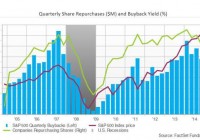JPN: A New Way To Invest In Japan
Summary Barron’s says it’s time to get long Japan. Deutsche Bank listed a new Japan ETF at the end of June. This new ETF may be an excellent way to buy Japan. On July 18th, Barron’s published an article titled, ” Time to Buy Japan’s Blue Chips .” Given that, and given that some investors may be seeking to gain exposure to Japan, I thought I would discuss and analyze one of the newest ways to get long Japan. The Deustche X-trackers Japan JPX-Nikkei 400 Equity ETF (NYSE: JPN ), freshly listed on June 24th, is Deutsche Bank’s newest Japan ETF, and the first U.S. listed ETF that tracks the JPX-Nikkei 400 Index. In this brief analysis, I will take a look at the underlying index that JPN tracks, how the fund is structured and how it compares to another Japan ETF. The Underlying Index To begin my analysis of JPN, I will first describe how the underlying JPX-Nikkei 400 Index works. This index is based on the 400 highest scoring (more on the “score” in a moment) listings from the JASDAQ and TSE. The scores are based on a four-part selection process, which begins with this screening: Listed for at least 3 years Must be common stock More assets than liabilities in the last 3 fiscal years No operating or overall deficit in the last 3 fiscal years Not designated to be de-listed After this initial screening, the top 1000 listings are selected based on market cap and trading value from the last 3 years. Those 1000 listings are then scored based on quantitative factors: 3-year average Return on Equity (40% weighting) 3-year cumulative operating profit (40%) Market capitalization (20%) Then, scoring based on qualitative factors is added where present: Appointment of independent outside directors Adoption of IFRS (International Financial Reporting Standards) Disclosure of English earnings information The top 400 listings are selected from the 1000 initially screened. I would also note that no single component makes up more than 1.5% of the index. Components JPN consists of 284 holdings. The fund is heavily weighted in industrials (20.28%), financials (18.96%), and consumer discretionary (17.08%). The top 10 holdings are as follows: KDDI Corporation ( OTCPK:KDDIY ) (Telecommunications – 1.83%) Nippon Telegraph and Telephone (NYSE: NTT ) (Telecommunications – 1.83%) Mitsubishi UFJ Financial Group (NYSE: MTU ) (Financials – 1.75%) Toyota Motor Corp (NYSE: TM ) (Consumer Goods – 1.62%) Mizuho Financial Group Inc (NYSE: MFG ) (Financials – 1.59%) FANUC LTD ( OTCPK:FANUY ) (Industrials – 1.55%) Japan Tobacco ( OTCPK:JAPAY ) (Consumer Goods – 1.54%) Mitsui Fudosan Company ( OTCPK:MTSFY ) (Financials [Real Estate] – 1.52%) SMC Corporation ( OTCPK:SMCAY ) (Industrials – 1.50%) Central Japan Railway Co. ( OTCPK:CJPRY ) (Services – 1.49%) Given that there is no major concentration in any one listing, I would say that this ETF is fairly well diversified. However, it is heavily weighted in the 3 aforementioned sectors, which make up a combined 56.32% of the portfolio. The other 43.5% of the portfolio comes from a combination of information technology, consumer staples, health care, telecommunication services, materials, utilities, energy, and “other.” The least represented sectors are utilities and energy, each at < 1%. Comparison to EWJ One of the most popular and liquid Japan ETFs is the iShares MSCI Japan ETF (NYSEARCA: EWJ ). EWJ provides "targeted access to 85% of the Japanese stock market" by tracking the MSCI Japan Index. MSCI's broad index composition methodology is based on market capitalization and liquidity. In this regard, EWJ's underlying is less selective than JPN's underlying. As a result, the MSCI Japan Index is currently up 14.36% YTD while the JPX Nikkei-400 Index is up about 17.50% YTD. EWJ has the same top 3 sector representations, although they are weighted differently. The most weighted sector in EWJ is consumer discretionary (22%), followed by financials (19.64%) and industrials (18.90%). EWJ is also arguably less diversified, with over 9% of the portfolio's value held in just two listings (Toyota Motor Corporation at 6.11% and Mitsubishi UFJ Financial Group at 3.05%). EWJ's expense ratio, at .47%, is marginally higher than JPN's, which is .40%. Just for reference, other Japan ETFs include: WisdomTree Japan Hedged Equity ETF ( DXJ) WisdomTree Japan SmallCap Dividend ETF ( DFJ) Deutsche X-trackers MSCI Japan Hedged Equity ETF ( DBJP) iShares Currency Hedged MSCI Japan ETF ( HEWJ) Conclusion My personal opinion is that JPN may offer better aimed exposure than EWJ because it tracks an underlying that adheres to a more strict selection process. However, a prospective investor should note that it is fairly illiquid right now, given that it is brand new. Furthermore, it should also be noted that there are other Japan ETFs that are currency hedged, which some may prefer depending on one's view of current macroeconomic conditions. While it is still early in the life of JPN, I think it is a fund worth further investigation if one of your goals is to be invested in quality Japanese equities. Disclosure: I/we have no positions in any stocks mentioned, and no plans to initiate any positions within the next 72 hours. (More...) I wrote this article myself, and it expresses my own opinions. I am not receiving compensation for it (other than from Seeking Alpha). I have no business relationship with any company whose stock is mentioned in this article. Additional disclosure: This article is not intended to be a recommendation to buy or sell Japanese equities. It is intended simply to break down a new product that may be useful to investors who have a long bias on the Japanese equity markets.
